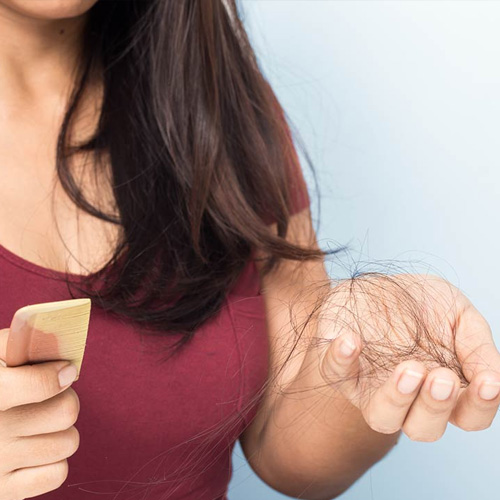Hair Fall

Hair loss refers to a loss of hair from the scalp or body. The medical term for hair loss is alopecia. There are many different causes of alopecia, some permanent, others temporary. Hair loss is more common in men, affecting 60% of men and up to 40% of women.
Hair is composed of a protein called keratin. Hair grows everywhere on our skin, except for on our palms and the soles of our feet. The average adult head grows about 100,000 to 150,000 hairs, and 80 to 100 are normally shed each day. At any one point in time, around 90% of the hair on the scalp is growing. This is known as the anagen phase. There are three main phases of hair growth:
- Anagen phase. On average hair grows 0.3-0.4 mm/day or around 12-15cm per year, although this is genetically predetermined. As people age, their rate of hair growth slows. The hair root looks long, white, and tapered during this phase
- Catagen phase. Hair growth stops during this phase and the hair root starts to shrink and become rounded. This phase may last from two to three weeks
- Telogen phase. This is also called the resting stage. The hair root is now fully rounded, and awaiting the growth of a new anagen hair to push it out of the scalp so it can be shed. This phase lasts around three to four months for scalp hair.
Types of Hair Loss
Hair loss can affect small areas of the scalp or occur evenly over the whole area. Depending on the cause, other hairy parts of the body may also be affected. The most common types of hair loss are:
- Male-pattern hair loss (baldness)
- Female-pattern hair loss
- Telogen effluvium (excessive shedding of telogen hairs)
- Anagen effluvium (excessive shedding of anagen hairs)
- Alopecia areata
- Other causes.
Male-Pattern Hair Loss
Male-pattern hair loss is an inherited condition and is also known as androgenetic alopecia. It is the most common type of permanent male baldness and affects male Caucasians more than other ethnicities. The condition is characterized by a receding hairline and/or hair loss on the top of the head.
Male-pattern hair loss is caused by an inherited increased sensitivity to dihydrotestosterone (DHT). DHT shortens the anagen phase of the hair cycle, causing progressively finer hairs to be produced. Men who do not produce testosterone (because of genetic abnormalities or castration) do not develop this pattern baldness. Male-Pattern hair loss affects about 20% of men in their 20s, 30% in their 30s and nearly half of men in their 40s.
Female-Pattern Hair Loss
Female-pattern hair loss is another inherited condition, although the pattern of hair loss is different from that of men. Female-pattern hair loss is characterized by a diffuse thinning of hair on the scalp or a widening of the center part, due to an increase in hair shedding. The frontal hairline usually remains intact.
The condition is more common near menopause affecting around 40% of women aged 50 and 55% of women aged 80.
